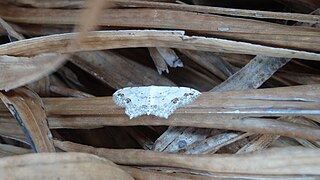Scopula actuaria is a moth of the family Geometridae. It was described by Francis Walker in 1861. It is found throughout the Oriental tropics of India, Sri Lanka, from Afghanistan and Taiwan to the southern Moluccas and Timor. It is also found on the Chagos Archipelago.
Scopula annularia is a moth of the family Geometridae first described by Charles Swinhoe in 1890. It is found from the north-eastern Himalayas to Hong Kong, Myanmar, Sumatra, Borneo, Java, the Philippines, Sulawesi and Seram.
Scopula deflavaria is a moth of the family Geometridae. It is found in Indonesia.
Scopula hyphenophora is a moth of the family Geometridae. It is found in India, Peninsular Malaysia and on Borneo and Bali. The habitat consists of lowland primary and secondary forests, alluvial forests and forests on limestone.
Scopula inficita is a moth of the family Geometridae. It is found in Indonesia and the Philippines.

Scopula mecysma is a moth of the family Geometridae first described by Charles Swinhoe in 1894. It is found in the Himalaya, Taiwan, Thailand and on Borneo, Java, Bali, Sulawesi and New Guinea. The habitat consists of lowland forests.
Scopula melinau is a moth of the family Geometridae. It is found on Borneo. The habitat consists of dipterocarp forests.
Scopula ocellata is a moth of the family Geometridae. It is found on Sumbawa, Sumatra and Java.
Scopula pallidiceps is a moth of the family Geometridae. It is found on Lombok, Bali, Java and possibly Borneo.
Scopula sybillaria is a moth of the family Geometridae first described by Charles Swinhoe in 1902. It is found in western China, Hong Kong and possibly Borneo.
Scopula usticinctaria is a moth of the family Geometridae. It is found on Borneo and Peninsular Malaysia.
Scopula pauperata is a moth of the family Geometridae. It is found on Borneo. The habitat consists of lowland forests.

Scopula pulchellata is a moth of the family Geometridae. It is found in the Indo-Australian tropics, from India, Sri Lanka to Taiwan and the Solomon Islands, as well as in Africa.
Scopula quadratisparsa is a moth of the family Geometridae. It is found on Borneo.
Scopula subdecorata is a moth of the family Geometridae. It is found on Borneo.
Scopula vacuata is a moth of the family Geometridae. It is found on Borneo. The habitat consists of lowland forests but it can occur as high as 1,000 metres in the lower montane forest zone. The species is often found in softwood plantations and secondary forests in lowland Sabah.
Scopula succrassula is a moth of the family Geometridae. It is found on the Philippines and Borneo.
Scopula tenuispersata is a moth of the family Geometridae. It is found on Sumatra and possibly Borneo.
Scopula urnaria is a moth of the family Geometridae. It is found on Peninsular Malaysia, Borneo and Palawan. The habitat consists of lowland dipterocarp forests.
Scopula voluptaria is a moth of the family Geometridae. It is found on Sumatra and Borneo.

